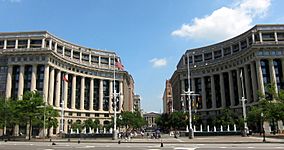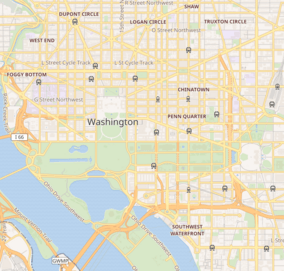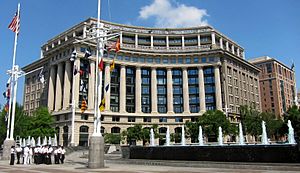United States Navy Memorial facts for kids
Quick facts for kids United States Navy Memorial |
|
|---|---|

United States Navy Memorial
|
|
| Location | Washington, D.C., U.S. |
| Established | October 13, 1987 |
| Governing body | U.S. Navy Memorial Foundation |
The United States Navy Memorial is a special place in Washington, D.C.. It honors all the brave people who have served or are currently serving in the Navy, Marine Corps, Coast Guard, and the Merchant Marine.
You can find it on Pennsylvania Avenue in Washington, D.C. It's near the Archives Metro station and the National Archives building. The National Park Service helps take care of the memorial.
Right next to the memorial is the Naval Heritage Center. This center is open all year. It has spaces that can be rented for events.
Contents
Early Ideas for a Memorial
Long ago, when the U.S. was just starting, an architect named Pierre Charles L'Enfant had an idea. He wanted a memorial in the nation's capital. This memorial would celebrate the Navy's beginnings. It would also honor its progress and achievements over time.
Pennsylvania Avenue was chosen as the perfect spot. This important street connects the U.S. Capitol building and the White House. It was decided that the memorial would honor all U.S. sea services.
Making the Dream Happen
President John F. Kennedy was a Navy hero in World War II. He helped inspire new plans for Pennsylvania Avenue. Later, in 1977, Admiral Arleigh Burke said it was time to build the Navy memorial. He felt people had talked about it long enough.
Admiral Burke had been a top Navy leader three times. In 1977, he started a group to create the U.S. Navy Memorial Foundation. This was a private, non-profit group. The next year, the foundation began its work.
Rear Admiral William Thompson led the foundation. They worked on getting laws passed and designing the memorial. They also chose the location and raised money.
Building the Memorial
In 1980, Congress approved the memorial. They said that all the money for it had to come from private donations. President Jimmy Carter signed this law in March 1980.
The foundation worked with another group to use Market Square for the memorial. They picked William Conklin and James Rossant as the architects.
By December 1985, enough money was raised. Construction started the very next month. By August 1987, a famous artist named Stanley Bleifeld finished the The Lone Sailor statue. The memorial was almost done. It was officially opened on October 13, 1987.
The Visitor Center
After the memorial was built, two more buildings went up nearby. One of them became the memorial's visitor center. Work on the inside of the visitor center began in September 1989.
The visitor center opened in June 1991. It was officially dedicated on October 12, 1991. Money is still being raised today. This helps pay off construction costs and supports educational programs.
In the summer of 2006, the water in the memorial's fountains turned blue. This was due to chemicals used to fight algae. A spokesperson said it was better to have blue water than green, algae-filled water. The blue color was gone by the end of the summer.
What You Can See at the Memorial
The main area of the memorial is called Memorial Plaza. Here you will find The Lone Sailor. This statue by Stanley Bleifeld honors all sea service members. It looks out over the Granite Sea.
The Granite Sea is a large map of the world's oceans. It is centered on Washington, D.C. Two fountains are also part of the plaza. They honor American Navy personnel and other navies around the world. Around the southern part of the plaza are 26 bronze artworks. These show important events, people, and groups from the sea services.
The Visitor Center and Its Exhibits
Next to the plaza is the United States Navy Memorial Visitor Center. Inside, you can find the Arleigh & Roberta Burke Theater. There are also different exhibits that change over time. These exhibits teach about the sea services.
You can also use Navy Log kiosks here. These touch-screen computers let you register or search for sea service members and veterans. The Visitor Center also shows films daily. These include At Sea and A Day in the Life of the Blue Angels. The Media Resource Center has a library of historical documents. These include printed, audio, and video materials about the Navy.
From June 2018 to June 2020, two exhibits were featured. One was The American Sailor: Agile, Capable, and Talented. It told the story of how the U.S. Navy began. It also showed how people have defended the country at sea. The other exhibit was Zumwalt: The Current that Brought the Navy to the Shores of the 20th Century. This exhibit shared stories and items from Admiral Zumwalt's life. It showed how he helped the Navy in the 20th century.
On an outdoor wall at the Navy Memorial, you can read many famous sayings. These quotes are from important moments in U.S. Navy history. Here are some of them:
- "I have not yet begun to fight!" – Captain John Paul Jones – 1779
- "Don't give up the ship!" – Captain James Lawrence – 1813
- "We have met the enemy and they are ours." – Commodore Oliver Hazard Perry – 1813
- "Damn the torpedoes, full steam ahead." – Admiral David Farragut – 1864
- "You may fire when you are ready, Gridley." – Commodore George Dewey – 1898
- "Speak softly and carry a big stick." – President Theodore Roosevelt – 1907
- "Sighted sub, sank same" – Aviation Machinist's Mate 1/c Donald Francis Mason – 1942
- "Underway on nuclear power." – Commander Eugene P. Wilkinson – January 17, 1955
- "That's one small step for (a) man, one giant leap for mankind" – Astronaut and Naval Aviator Neil Armstrong – July 20, 1969
- "I can imagine no more rewarding a career. And any man who may be asked in this century what he did to make his life worthwhile, I think can respond with a good deal of pride and satisfaction: 'I served in the United States Navy.'" President John F. Kennedy, 1 August 1963, at Bancroft Hall at the US Naval Academy,
Many other places also honor the U.S. Navy and sea services. Here are a few examples:
- Navy-Merchant Marine Memorial
- Peace Monument (Naval Monument)
- John Ericsson National Memorial
- John Paul Jones Memorial
- National Memorial Cemetery of the Pacific
- Perry's Victory and International Peace Memorial
- Port Chicago Naval Magazine National Memorial
- Various buildings and memorials at the U.S. Naval Academy
- USS Arizona Memorial (BB-39)
- USS Bennington Monument
- USS Indianapolis National Memorial
- USS Maine memorials
- USS South Dakota (BB-57)
- USS Utah Memorial (BB-31)
- Battleship Missouri Memorial – USS Missouri (BB-63)
- Battleship New Jersey Museum and Memorial – USS New Jersey (BB-62)
- U.S. submarines designated as memorials
- World War II Submarine Torpedo monument
- UDT-SEAL Memorial
- Seabees Memorial
- Various memorials for Lt. Vincent R. Capodanno
- Lt. Hans Grauert Memorial Field
- Ensign C. Markland Kelly, Jr. Award
- Lt. Donald McLaughlin Jr. Award
- YF-415 Memorial, Hingham, Massachusetts
Images for kids




